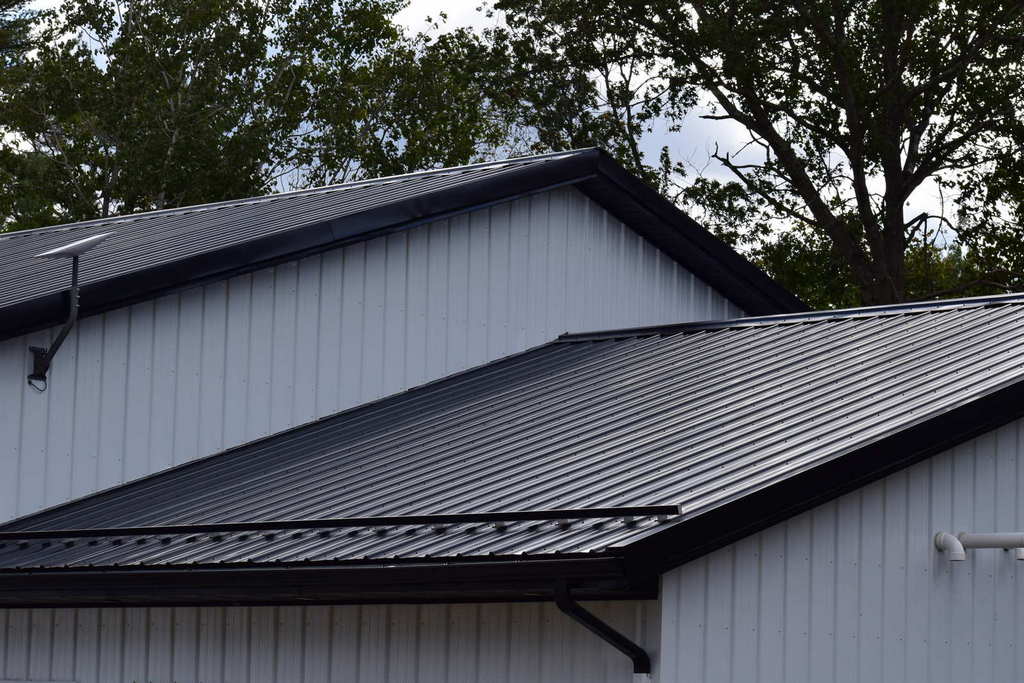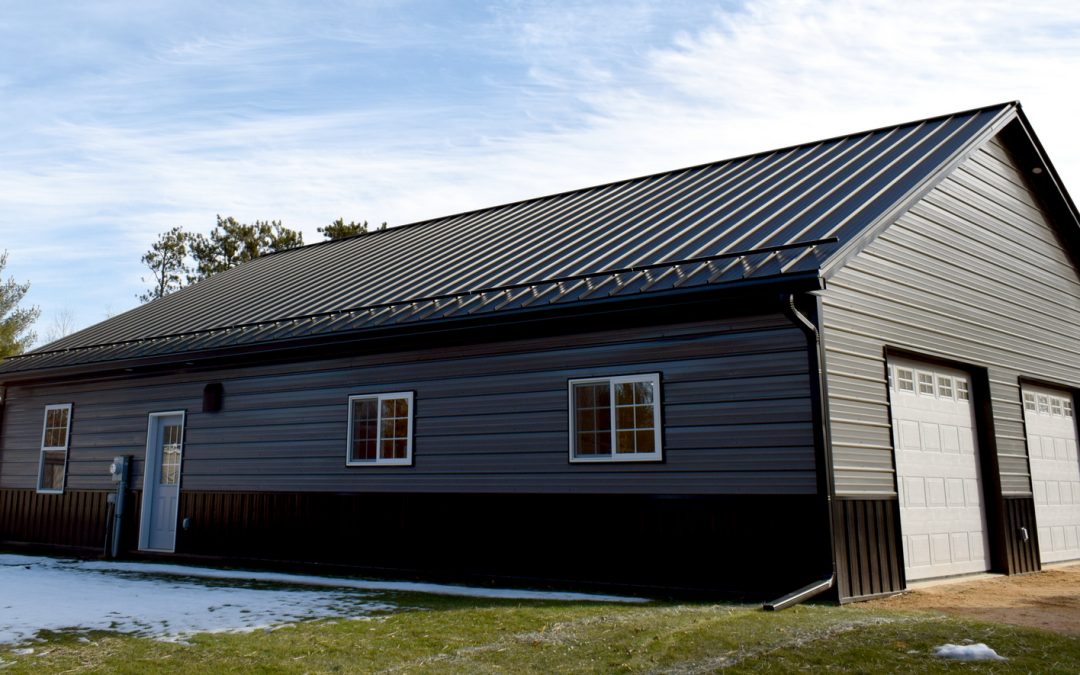We’ve all done it. Go to print something from a computer or electronic device. One of the main options before printing is choosing “landscape” or “portrait” orientation. The same thought process can be used in choosing the orientation of metal siding panels.
Are you considering new siding? Whether it’s replacing your existing siding, for a new construction home, or for commercial use, there are so many material options to choose from. And once you’ve decided that metal is the way to go, again, there are many options to choose from, such as the color, profile, and thickness panel gauge to use. Once you’ve made all of those decisions, then decide on the orientation of metal siding – will you have it installed vertically or horizontally?
All American Steel produces metal siding panels for commercial, agricultural, or residential use. It’s more common to see homeowners choose horizontal panel siding, while the vertical orientation of metal siding panels is more typical for commercial and agricultural buildings.
Let’s take a look into vertical and horizontal orientation of metal siding panels, so that it may help you decide which is best for you. But before we dive into each, let’s briefly cover how different metal panel profiles affect its orientation.
Exposed vs Concealed Fastener Metal Wall Panels
Exposed Fastener Panels Are More Commonly Installed Vertically
Revisiting the basics:
An “exposed” fastener panel wall system features fasteners (screw heads) that penetrate directly through the face of the metal panels in order to attach it to the structure. The screw heads are left visible; thus the name “exposed fastener.” Exposed fastener wall panels are more affordable, and easier to install.
A “concealed” (hidden) fastener metal panel wall system features panels that attach to the substructure without any fasteners visible. The panels are attached using concealed clips and fasteners for much more curb appeal.
Exposed fastener panels are more commonly installed with a vertical orientation. It’s most often seen as siding on pole sheds, barns, or commercial buildings where appearance is not the top priority. Vertical siding is preferred because it allows for easier cleaning and less maintenance than when panels are installed horizontally.
Concealed fastener panels are more frequently installed horizontally because they are commonly thought as to look more attractive when installed, and resemble other siding materials, like vinyl or lap siding. One of the biggest advantages of a concealed fastener panel system is obviously its appearance, since it has no screw heads showing, and a horizontal orientation fulfills that goal. Next, let’s dive into the orientation of metal siding.
Advantages of Horizontal Orientation of Siding
Horizontal Metal Siding Is More Attractive
The look of your siding is definitely a personal preference. Generally though, horizontal siding is considered to be the more common method of installing metal siding.
Horizontal Siding Has A More Traditional Look
Since horizontal metal siding is generally thought of as a preferred design appearance, it makes horizontal metal siding orientation more common.
Horizontal Siding Does Have Disadvantages
Horizontal Metal Siding Is Less Weathertight
Horizontal metal siding is less resistant to water because it lays horizontally. Any seams could potentially have seepage. Once water gets inside, it can run across the substructure due to the horizontal profile, exposing a greater surface area to moisture. A vertically placed panel, meanwhile, will see any potential seepage go straight down the inside of the panel.
Cleaning Horizontal Siding
Horizontal metal siding has more maintenance involved when it comes to cleaning. When the orientation of metal siding is run vertically, it can be quickly power washed or simply rinsed off with a hose, extra care must be paid to horizontal siding. You want to prevent water penetrating between the horizontal slats, as this could cause mold and mildew.
Choosing the orientation of metal siding can definitely reflect on how your home or building is viewed. If you want to add depth and generate interest in the exterior of your home, then the route to go would be installing the panels horizontally. With horizontal placement, it can create long lines going across the home and create the illusion of a bigger, longer building or home. Whether you want your entire exterior to be horizontal, or want to add a section with vertical panels, the options to achieve the style you want are virtually endless. Have fun in the design process and explore other options!
When metal siding is installed in a vertical position, it has a higher likelihood of being watertight, and becomes more resistant to water damage than its counterpart. The water will not get caught on the siding, but will just run off, straight down the panel.
Advantages & Disadvantages of Vertical Metal Siding
Maintenance of Vertical Siding
Metal siding is known for its low-maintenance status, but a vertical installation makes that maintenance even easier. Vertical siding typically does not get as dirty, and is easier to clean compared to horizontal siding. When the panels do need to be cleaned, simply pressure wash the siding, and the dirt will run straight down the panel and rinse right off.
Appearance of Vertical Metal Siding
Choosing between a vertical or horizontal orientation of metal siding panels is solely based on their aesthetics is a personal preference. However, horizontal siding is more traditional and much more commonly used (i.e. – vinyl siding, wood siding, and cement fiber lap siding are all horizontal), so it’s not like the record book is being rewritten. If you are wanting a unique look that will stand out, consider vertical siding, and even better, vertical metal siding panels.
Using vertical metal siding on the exterior of a home or building is a great way to create the illusion of a taller looking building. The ribs on some profiles that we produce will help create a seamless, stunning appearance, and even a board and batten look. Panels can be installed vertically complete across the entire exterior, just the facade, or choose to mix some horizontal areas to create texture or depth to offset the layout, and create uniqueness. Either way, vertical metal panels will definitely give your home a modern appearance.
Deciding Whether a Horizontal Or Vertical Orientation of Metal Siding Is Right For You
As previously discussed, deciding on a vertical or horizontal orientation for your metal panel siding depends on your visual preference when you’re just focused on aesthetics. However, when taking the other factors into consideration, make sure to consider these other factors:
Reasons to Select a Vertical Orientation of Metal Siding
Less maintenance and easier cleaning
Climates where maximum durability is needed
A more unique look
Reasons to Select a Horizontal Orientation of Metal Siding
A more traditional look
Personal Preference
Contact the team at All American Steel today on our website or by calling 608-377-7200 and get an estimate on materials for both an exposed fastener system and standing seam / concealed fastener system. We can do the design work, renderings, materials lists, provide the materials, and handle delivery to the jobsite. You can also visit our display at the All American Do it Center home improvement stores in Tomah, Sparta, or Richland Center Wisconsin.



